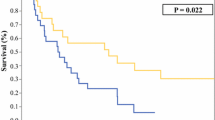Abstract
Background
Division of retroperitoneal liposarcoma (RPLS) into well-differentiated (WD) and dedifferentiated (DD) subtypes is established; however, WD and DD are usually treated similarly. We hypothesized that WD and DD have distinct biological behaviors mandating different treatments.
Methods
A prospective sarcoma database identified all primary/recurrent RPLS treated between 1996 and 2007: 77 DD (52%) and 58 WD (39.2%) patients were analyzed for recurrence rate, recurrence free survival (RFS), and overall survival (OS).
Results
At presentation, WD were mostly primary whereas DD were mostly recurrent (75.9% versus 58.4%; p = 0.04). A significant proportion of DD (37.7%) received chemotherapy compared to WD (1.7%; p < 0.0001). Multivisceral resection was more common in DD versus WD (45.5% versus 31%; p = 0.01). Gross total resection rates were equivalent (WD: 86.2%; DD: 85.7%). Overall and local recurrence were higher in DD versus WD (82.2% versus 50% and 71.2% versus 46.3%; p < 0.0001). Only 3.7% WD recurred as high grade metastatic disease. Median time to recurrence was 55.5 months in WD versus 13.5 months in DD (p < 0.0001). RFS and OS (1, 2, and 5 year) were higher in WD than DD (80.3% versus 55.9%; 65.1% versus 34.1%; 41.9% versus 7.8%; p < 0.0001) and (98% versus 88.1%; 95.6% versus 71.9%; 92.1% versus 36.5%; p < 0.0001) respectively.
Conclusion
WD and DD have distinct biological behaviors. Gross total resection is achievable in most WD; unlike DD, high-grade recurrence is uncommon. Treatment should therefore reflect these biologic differences by maximizing survivorship while avoiding unnecessarily extensive multivisceral resection.
Synopsis
The biological behaviors of well-differentiated and dedifferentiated liposarcomas differ significantly. This article presents outcomes of two different surgical approaches that were implemented at the UTMDACC, treating these tumors as different disease entities.


Similar content being viewed by others
References
Dei Tos AP. Liposarcoma: new entities and evolving concepts. Ann Diagn Pathol 2000; 4:252–66
Linehan DC, Lewis JJ, Leung D, et al. Influence of biologic factors and anatomic site in completely resected liposarcoma. J Clin Oncol 2000;18: 1637–43
Mack T. Sarcomas and other malignancies of soft tissue, retroperitoneum, peritoneum, pleura, heart, mediastinum, and spleen. Cancer 1995; 75:211–44
Enzinger FM, Weiss SW. Liposarcoma: soft tissue tumors, 3rd ed. St. Louis: CV Mosby, 2001
Fletcher CDM, Unni K, Mertens F. Pathology and genetics of tumours of soft tissue and bone. Lyon, France: International Agency for Research on Cancer (IARC), 2002
Evans HL. Liposarcoma. A study of 55 cases with a reassessment of its classification. Am J Surg Pathol 1979; 3:507–23
Fabre-Guillevin E, Tabrizi R, Coulon V, et al. Retroperitoneal liposarcomas: follow-up analysis of dedifferentiation after clinicopathologic reexamination of 86 liposarcomas and malignant fibrous histiocytomas. Cancer 2006; 106:2725–33
Neuhaus SJ, Barry P, Clark MA, et al. Surgical management of primary and recurrent retroperitoneal liposarcoma. Br J Surg 2005;92:246–52
Gronchi A, Casali PG, Fiore M, et al. Retroperitoneal soft tissue sarcomas: patterns of recurrence in 167 patients treated at a single institution. Cancer 2004;100:2448–55
LinehanDC, Lewis JJ, Leung D, et al. Influence of biologic factors and anatomic site in completely resected liposarcoma. J Clin Oncol 2000;18:1637–43
Singer S, Antonescu CR, Riedel E, et al. Histologic subtype and margin of resection predict pattern of recurrence and survival for retroperitoneal liposarcoma. Ann Surg 2003; 238:358–70
Kaplan EL, Meier P. Nonparametric estimator from incomplete observations. J Am Stat Assoc 1958; 53:457–81
Mantel N. Evaluation of survival data and two new rank order statistics arising in its consideration. Cancer Chemotherapy Rep 1966; 60:163–70
Cox DR. Regression models and life tables (with discussion). J R Stat Soc B 1972; 34:187–220
Venables WN, Ripley BD. Modern applied statistics with Splus, 3rd ed. New York, Springer, 1999
Bautista N, Su W, O’Connell TX. Retroperitoneal soft-tissue sarcomas: prognosis and treatment of primary and recurrent disease. Am Surg 2000; 66:832–6
Malerba M, Doglietto GB, Pacelli F, et al. Primary retroperitoneal soft tissue sarcomas: results of aggressive surgical treatment. World J Surg 1999; 23:670–5
Gutierrez JC, Perez EA, Franceschi D, et al. Outcomes for soft-tissue sarcoma in 8249 cases from a large state cancer registry. J Surg Res 2007;141:105–14
An JY, Heo JS, Noh JH, et al. Primary malignant retroperitoneal tumors: analysis of a single institutional experience. Eur J Surg Oncol 2007;33:376–82
Evans HL. Atypical lipomatous tumor, its variants, and its combined forms: a study of 61 cases, with a minimum follow-up of 10 years. Am J Surg Pathol 2007;31:1–14
Singer S, Corson JM, Demetri GD, et al. Prognostic factors predictive of survival for truncal and retroperitoneal soft-tissue sarcoma. Ann Surg 1995;221:185–95
Karakousis CP, Gerstenbluth R, Kontzoglou K, et al. Retroperitoneal sarcomas and their management. Arch Surg 1995;130:1104–9
Erzen D, Sencar M, Novak J. Retroperitoneal sarcoma: 25 years of experience with aggressive surgical treatment at the Institute of Oncology, Ljubljana. J Surg Oncol 2005;91:1–9
Acknowledgement
This manuscript was partially sponsored by an AJCC grant (to R.P.)
Author information
Authors and Affiliations
Corresponding author
Rights and permissions
About this article
Cite this article
Lahat, G., Anaya, D.A., Wang, X. et al. Resectable Well-Differentiated versus Dedifferentiated Liposarcomas: Two Different Diseases Possibly Requiring Different Treatment Approaches. Ann Surg Oncol 15, 1585–1593 (2008). https://doi.org/10.1245/s10434-007-9805-x
Received:
Revised:
Accepted:
Published:
Issue Date:
DOI: https://doi.org/10.1245/s10434-007-9805-x




